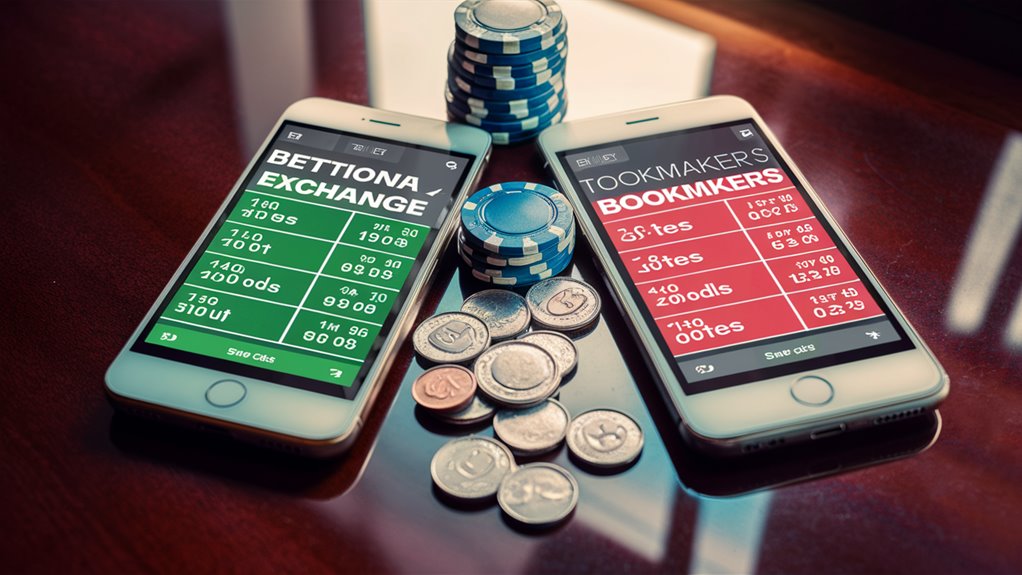
Betting Exchanges vs. Traditional Bookmakers
Betting Exchanges vs Traditional Bookmakers: The Ultimate Look

Main Differences in Betting Ways
Peer-to-peer betting in exchanges changes 이 자료 참고하기 sports betting by only taking 2-5% from wins. Traditional bookmakers use set odds and add 5-15% across all plays, no matter the end.
What Betting Exchanges Do Better
Better odds are often seen on exchanges, giving 20-30% more than bookmakers. The exchange edge stays very good at 101-102%, while bookmakers range from 107-115%.
Getting to Bets and Limits
Good Points of Exchanges
- No limits on winning
- Clear prices
- More money can be made
Downsides of Bookmakers
- Limits on good betters in three months
- Set edge rates
- Smaller top bets
What You Need to Know Tech-wise
Exchanges need:
- Busy markets
- Top trade skills
- Knowing tech well
- Seeing market depth
With better odds, smaller cuts, and no betting caps, exchanges are the top pick for expert betters wanting steady money from sports bets.
The Basic Differences Between Betting Exchanges and Bookmakers
Basic Business Ways
Betting exchanges and traditional bookmakers run on different rules in the betting world.
Bookmakers set solid odds and make money from the gap between real chance and offered odds.
In contrast, exchanges let users both back (bet for) and lay (bet against) ends, supporting peer betting.
Money and Price Making
Looking at markets shows bookmakers keep big edges of 5-15% on main sports.
Exchanges have a better setup, only taking 2-5% on wins. This often means 20-30% better odds than bookmakers.
The exchange setup takes away the need for bookmakers to even their books by directly matching bets against each other.
How Clear and Good Markets Are
Exchange setups give great price power with their peer trading model. These show real odds that lots see as a good sign.
The setup helps see through things by showing money levels at each price and letting users track money moves.
On the other hand, bookmakers often set limits or stop good betters to keep their money edge.
Top Points of Exchanges
- Prices driven by the market
- Clear view of pricing
- Low cut rates
- No limits on wins
- Ways to bet both sides
How Betting Exchanges Work

Basics of Betting Exchange Sites
Exchanges run by a sharp peer-to-peer match system linking users wanting to back and lay particular ends.
Unlike bookmakers, exchanges let users bet with each other, taking a small cut of 2-5% on wins.
The Matching Work
The real-time match system is key to exchange work.
When someone bets to back at certain odds, the site looks for another who wants to lay that bet at those odds. Bets not matched stay open in the order book till they match or the user changes them.
Playing Both Sides
A big plus of exchanges is being able to both back and lay bets, letting users act like both betters and bookmakers.
This two-way play makes a very effective market where odds truly reflect real chances better than standard sportsbooks.
How Much Money is There
Money ready to bet changes a lot with different events.
Big games like Premier League ones often pull in over £10 million in bets, giving lots of chances to trade.
But, less known events might not have much money ready, touching how well users can get the odds they want and carry out their plans.
Main Bits
- Peer-to-peer bet setup
- Money-making from cuts
- Live odds matching
- Back and lay options
- Changing money ready
Old-School Booking: Full Look
Basic Bits
Old booking works as a central odds setting and risk watch where licensed folks control prices and bet taking.
Bookmakers use smart price making and risk plans to start odds, adding edges of 5-15% across different sports.
Handling Odds and Risk
Pro bookmakers keep tweaking odds based on how much is bet and what risks they face.
Their moving price system answers to market moves, with risk plans letting them change things fast. Stats show that about 95% of winning accounts get limits within three months of good wins.
Edges and House Hand
The bookmaker’s good spot stays by using the overround idea – where all possible ends add up to over 100%. In football bets, they usually start with:
- Initial thought hold of 107%
- Moving edges going to 115% when busy
- Average yearly big game money gains of 6-8%
How the Market Moves
Betting folks use smart systems to:
- Watch how bets go
- Change odds live
- Watch risk
- Keep making money
- Hold market risks
This smart way helps keep making money while watching risks over different sports and bet markets.
Looking at Betting Exchange Odds vs Bookmaker Worth
Getting the Odds Right
Betting exchanges often give way better worth than old bookmakers, with up to 20% better odds in big sports.
This big price plus comes from the peer bet model, cutting out the bookmaker’s edge.
How Good Markets Are
Overround Look
The total chance percent (overround) shows big differences between platforms:
- Betting Exchanges: 101-102%
- Old Bookmakers: 107-115%
Premier League Example
Football bet markets show clear worth gaps:
- Exchange odds: 2.00 (even money)
- Bookmaker odds: 1.85 (same pick)
Chances in Less Known Markets
The odds gap gets even bigger in less known markets:
- Up to 30% more worth in these smaller bet areas
- Wider edges seen in less followed sports
- Bigger money chances in markets not well served
How Cuts Impact
While cuts (2-5%) on exchanges can lower the price lead, smart betters still get:
- 8-12% better worth in most areas The Benefits of Playing at Multiple Online Casinos
- Higher money wins after the cut
- Better long-run money chances with smart bet plans
Looking Closer at Market Worth
The bet worth gap changes with:
- Big sports leagues
- Event-focused markets
- Less known bet choices
- Live bet chances
This wide price plus makes exchanges more and more picked by those looking for top returns.

